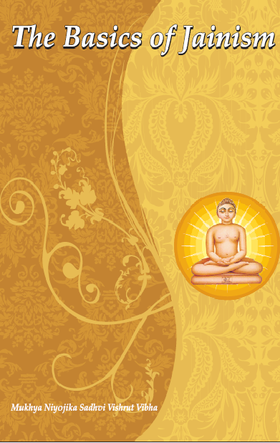The code of conduct of a jain ascetic is very strict, and a person may find it difficult to follow the rules and regulations. Lord Mahavira realised this fact two thousand six hundred years ago and he devised two categories of spiritual practices: one called the Anagara and the other the Agara Dharma. As mentioned in the previous chapter, the Anagara Dharma is for the ascetics who completely renounced the world, and the latter is for those who remain in "worldly existence" and form the majority. The Agara Dharma entails a code of conduct called "Anuvrat" (lesser vows) which are a milder version of the five vows undertaken by the ascetics. In addition to these lesser vows, seven auxiliary vows called Guna Vratas and Shiksha Vratas are also prescribed for the layman. These codes of conduct along with twelve "householder" vows are together known as Agara Dharma. The five anuvrats are:
- Ahimsa:
The first anuvrat insists a person to abstain from violence through mind, body and speech as much as possible. At least he must avoid the killing of innocent living beings knowingly. This can be highlighted by following example:-There was a Jain commander in Gujarat. Suddenly enemies attacked his city. The king was away. When the queen came to know about it, she called the commander and said that she would fight the war. The commander requested the queen to stay in the palace and they would manage. Then he set off with his soldiers. When they reached the battlefield the sun was about to set so they rested for the day. At the time of sunset the commander sat for pratikramana (a sort of expiation). He pronounced that if he had committed any violence to any creature, then he atone for it. When the soldiers heard these words, one of them went to the queen and asked how that commander could protect our country, when he was atoning for killing creatures. The queen was astounded. She went to him and asked the commander, whether he could really fight against enemies. The commander told that he would fight for the defense of the country. Next day he fought the battle and was victorious. By this instance we can understand that to adhere to social responsibilities some violence is unavoidable, but that we should not indulge in violence for pleasure or greed. For example, in present context one can limit the use of water, electricity means of transportation etc. in which violence is done for a particular time duration.
- Truth:
In the second anuvrat, the householder is called upon to be truthful. He must avoid lying, giving false evidence, deceiving and cheating others. At times we should abstain from speaking the truth which might hurt or harm innocent beings.
- Non-stealing:
In the third anuvrat, a layman must avoid possessing anything that does not belong to him. It can be a friend's pencil or other people's wealth.
- Svadara Santosh:
In the fouth anuvrat, one should limit one's sexual relations only to one's own spouse. This does not mean merely avoiding adultery, but also advocates limiting sexual acts within the conjugal relationship. Sexual indulgence of all kinds entails passions and should be subdued and not inflamed, and therefore sexual desire should be restricted. This vow today seems more relevant when he dragon of and seems to swallow the mankind.
- Non-possession:
In the fifth anuvrat, a layman should abstain from the possession of unnecessary belongings. It is not possible to renounce all property but he may easily limit its accumulation(e.g. land, house, gold, jewellery and other valuables). In accumulating property, one's attachment to it is unavoidable. Therefore, one should limit his possession for everyday use. This vow can solve the economic problems aroused due to unequal distribution and unnecessary use of wealth.
Apart from these five major vows, there are seven supplementary vows. These vows are:
- Digvrata:
To limit one's movement in six directions and give up performing any sinful activities including business etc. in a place outside the area as accepted in the vow.
- Bhogopabhoga-parimanavrata:
In this vow, limitation is imposed on all kinds of articles. The things which can be consumed once like food, drinks etc. are called bhoga and semi permanent substances like clothes ornaments, vehicles etc. that are reusable are called upobhoga. This vow restricts the consumption or usage of material things, whether they are usable only once or repeatedly. This draws a line of limitation around the sphere of desires.
- Anarthadanda virati:
To abstain from all unnecessary violence.
- Samayika virata:
This entails the complete abstention from all sinful activites for one muhurta (48 minutes) at a time. This requires one to sit with the least of movement and concentrate on oneself.
- Desavakasika vrata:
This requires the renunciation of violence and sinful activities for a fixed time.
- Pausadha vrata:
This vow consists of total fasting by giving up all kinds of foods and drinks from one sunrise to the next sunrise and doing meditation and religious activities for that period.
- Atithisamvibhaga-vrata:
It is the duty of every householder to offer food and drink to the monks after carefully avoiding all blemishes of pindaisana (offerings). However, it is a sin to prepare something extra for their sake. That which is given to the ascetics must come from what was intended for oneself. A person who follows all these vows with the true spirit and honesty will be an ideal householder, which is essential for a good society and also for the nation.
